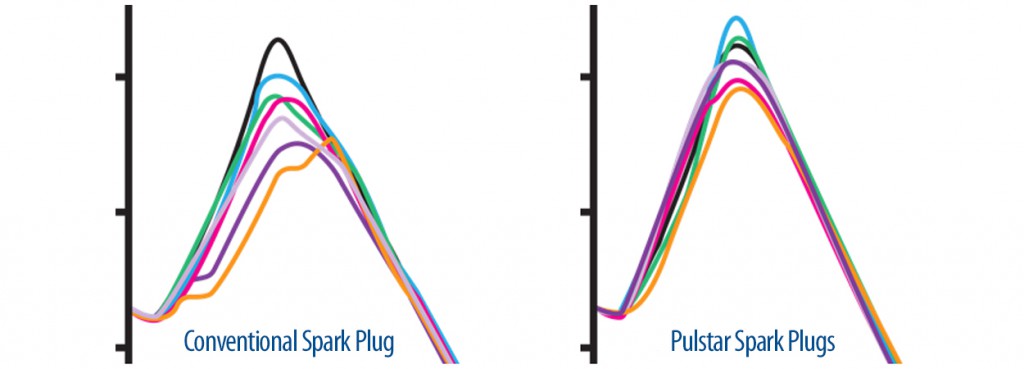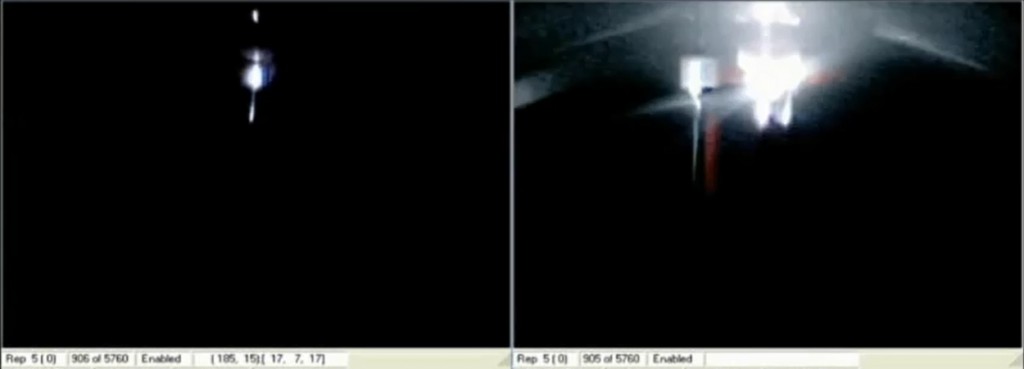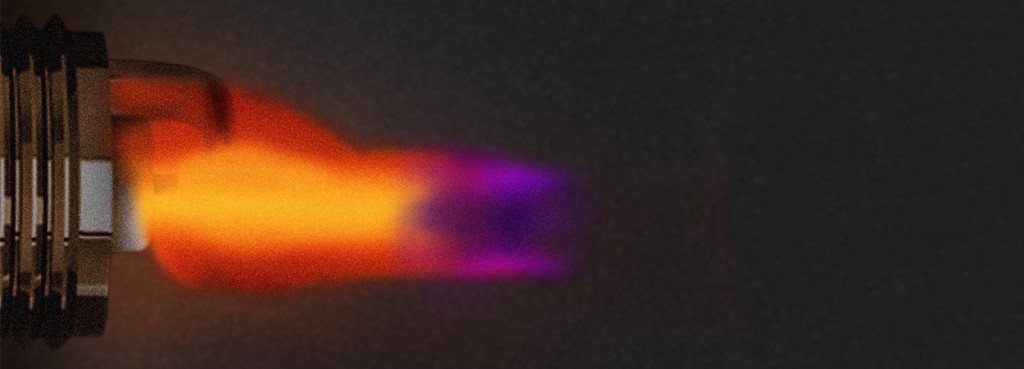Lab Testing
Reduced CoV of IMEP

Pulstar Spark Plugs have shown combustion improvement in average engines. Atmos Energy, a natural gas compression company, tested the effect of Pulstar Spark Plugs on large diameter (over 12”) cylinder engines. Conducted on a Clark TLAD-8 3,200 horsepower integral compression reciprocating engine, Pulstar Spark Plugs showed noticeable cycle-to-cycle combustion consistency.
Data was gathered by getting the engine to operating temperature and then gathering baseline test data of peak combustion pressure of one cylinder for eight cycles. Next, the engine was shut down and the conventional spark plugs were replaced with the appropriate Pulstar Spark Plugs. The engine was then restarted and peak compression pressure recorded for another eight cycles. Each cycle is represented by a colored trace. Pulstar Spark Plugs noticeably increase peak pressure consistency relative to the peak pressure produces by the conventional Spark Plug. The measured improvement in precise ignition results in a 50% reduction in CoV of IMEP; the average peak pressure is higher for the Pulstar Spark Plug as well, which results in greater torque produced from the same amount of fuel.
Testing By: Atmos Energy
Faster Burn

AVL is an Austrian-based automotive consulting firm and independent research institute. They are well known in the automotive industry and among original equipment manufacturers (OEMs). Captured by AVL using a process known as Schlieren high-speed photography, this video shows Pulstar’s 5MW pulse followed by the plasma affected fuel mixture burning at an increased rate compared to conventional spark plug. Filmed at 64,000 frames-per-second, this independent third-party test shows a side-by-side comparison of Pulstar and the top-selling premium iridium spark plug.
A quartz engine cylinder was implemented to video the combustion process in dynamic engine operation. The transparent engine, developed by AVL, allows for visual dynamic analysis of a spark ignited engine in operation. The actual ignition event, initial flame kernel and combustion propagation through 50% of the fuel charge can be seen. The state of the art testing platform featured an engine with a sweep volume of 500cc and utilized turbo charging, valve phasing, and direct injection. The test planned to determine if plasma created by the Pulstar Spark Plugs initiated combustion more consistently cycle-to-cycle and/or reduced the 0-50% mass fractional burn (MFB). A shorter 0-50% MFB as a result of more consistent ignition indicated an improvement of combustion stability especially in catalyst heating operation.
Matthias Neubauer of AVL co-authored a paper with Enerpulse’s founder and chief technology officer Lou Camilli that researched the effects of this 5MW pulse on fuel consumption, emissions, and catalyst heating. The paper, titled High Power Discharge Combustion Effects on Fuel Consumption, Emissions, and Catalyst Heating was reviewed and published by the Society of Automotive Engineers (SAE) for the SAE 2014 International Powertrain, Fuels & Lubricants meeting.
Testing By: AVL
Existence of Plasma

Tests conducted at one of the US’s largest certified independent research and development institute (undisclosed due to non-disclosure agreement) visibly captured the non-equilibrium plasma zone created by Pulstar. Using Schlierin photography in a quiescent pressure vessel, the institute captured the instant the resistance in the spark plug gap was overcome and a spark produced. These images are single frames taken from the 64,000/ fps video; they compare the spark of a conventional premium fine wire iridium spark plug to the discharge of Pulstar’s embedded capacitor taken at the identical cycle time. This test captured Pulstar’s intense electrical discharge successfully producing a plasma field.
Additionally, testing conducted at this well-known independent third-party lab proves Pulstar spark plugs burn the fuel mixture at a significantly accelerated rate when compared to the premium iridium fine-wire plugs of the world’s top two leading spark plug manufacturers.
The spark from a spark plug can only impact the first 2-5% of the combustion process. This is called the 5% Mass Fractional Burn (MFB). In independent third-party testing, Pulstar with PlasmaCore’s 5% MFB was measured against the leading brand’s premium iridium spark plug in a quiescent cylinder. The flame kernel area growth measured by pixels shows the flame growth at 500 microseconds (0.5 milliseconds) for the Pulstar with PlasmaCore spark plug at 200 pixels while the premium iridium spark plug is only about 50 pixels. At 2,750 microseconds (2.75 milliseconds), the Pulstar flame kernel comprises 600 pixels compared to the iridium spark plugs 90. At 0.5 milliseconds the Pulstar with PlasmaCore spark plug’s flame kernel is 4 times the size of the leading brand’s premium iridium spark plug; and its burn rate is accelerated, increasing to 6.7 times larger at 2.75 milliseconds.

These results not only reflect the Pulstar’s capacity to burn more of the fuel quickly; they also show its ability to ignite a lean 18:1 air-fuel mixture and burn it at an accelerated rate – improving MPG.
Additional tests conducted at this labratory compares the flame propagation rate of the Pulstar with PlasmaCore a different leading brand’s premium iridium spark plug. Again, the flame propagation rate of Pulstar is significantly faster at 63%. The below pictures show the Pulstar flame kernel is clearly larger at 13,707 microseconds (0.013 milliseconds) and 33,187 microseconds (0.033 milliseconds) than the leading brand’s premium fine-wire iridium spark plug.


 0
0